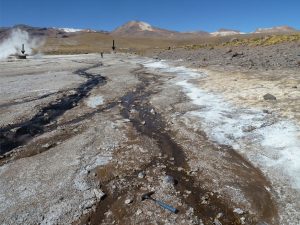14 December 2016
Finger-like structures on Mars could be the result of ancient microbes
Posted by dgaristo
By Yasemin Saplakoglu

Discharge channels from hot springs (arrows) deposit silica in El Tatio, Chile. El Tatio lies at the edge of the Atacama Desert where dry conditions are conducive of a Mars-like environment.
Credit: Steven W. Ruff, Jack D. Farmer, Nature communications, CC BY 4.0.
Finger-like rock structures on Mars could harbor potential evidence of past life on the Red Planet, according to new research. In 2007, NASA’s Spirit rover landed on Mars’ “Home Plate,” a flat 90-meter-long area within the Gusev crater. Since then, researchers have been trying to make sense of finger-like rock structures splayed across the landscape. The working hypothesis at the time was that these rocks started out as continuous layers but eroded into odd shapes by the touch of wind and sand over the years.
But a new study suggests it wasn’t erosion that created these shapes. Based on rock samples collected from hot springs in Chile, a team of researchers now hypothesize that photosynthetic microorganisms entombed within the rock may have created the unusual structures. The authors suspect the microbes pushed up toward the sunlight, creating the finger-like shapes seen today. They reported their findings in Nature Communications and presented their work at the 2016 American Geophysical Union Fall Meeting in San Francisco.
These findings suggest that the footprints of ancient life on Mars could be hidden within Home Plate.
Rewinding several billion years to understand the story of life on Mars is not an easy feat, but scientists are able to use some areas of Earth as analogs for the early Martian environment. El Tatio, a geyser field in northern Chile, lies at the edge of the Atacama Desert where dry conditions are similar to the Martian environment. Researchers recently found similarities between silica deposits on Mars and those in El Tatio’s hot springs—a finding that points toward evidence of past life on Mars, according to Steven Ruff, a planetary geologist at Arizona State University and lead author of the new study. “El Tatio could be what Mars looked like three and a half billion years ago,” Ruff said.
In the new study, the researchers collected silica samples from hot spring channels in El Tatio. Using a scanning electron microscope and a thin section microscope, they found that the silica samples from El Tatio were stromatolites—layered rocks formed by single-celled microbes. The texture and shape of these silica samples shows striking similarities to those found on Mars, suggesting the Martian rocks could have been formed by the same mechanism, according to Ruff.
The researchers also found that stromatolites in El Tatio contained halites, or salt. Using water and a toothbrush, they scraped salt off the El Tatio samples so they more closely resembled rock samples from Yellowstone National Park—another environment that has Martian characteristics. With the salt scraped off, the rocks’ composition was similar to that of Yellowstone rocks but very different from Home Plate samples. According to Ruff, this suggested two things: El Tatio is an area that closely resembles Mars and the samples on Mars could contain salt.

Textural comparison of rocks on home plate (left) and El Tatio (right).
Credit: Steven W. Ruff, Jack D. Farmer, Nature communications, CC BY 4.0.
“So there’s evidence now that it’s not only a silica story on Mars,” Ruff said. “Now it’s a silica plus halite story.”
However, some researchers don’t agree with Ruff. Richard Morris, an astrophysicist at NASA who was not part of the study, suspects acid from steam vents condensed on already existing rocks, dissolved all the other minerals, and left behind a silica residue that doesn’t easily precipitate—a process known as leaching.
“Both processes give a high silica composition, but I think it’s a leaching process which produces these silica residues,” Morris said.
According to Douglass Ming, a planetary scientist at NASA who was also not part of the study, there is more evidence suggesting an acidic environment in Home Plate, pointing more toward the leaching model, although he agrees Ruff’s study pointing to similarities between the samples from Mars and El Tatio is valid.
“That hypothesis is hard to support,” Ruff said, referring to the leaching counter-argument. “None of the existing rocks around home plate have that texture that mimics an acidic model.” According to him, it is unclear whether halites can even exist in an acidic environment.
The only way to be certain which hypothesis is correct is to collect rock samples from Mars, Ruff said. The next NASA rover mission to Mars is planned for 2020 and Ruff and his colleagues are advocating for going back to Home Plate. “Now that we have potential evidence of past life, we know where to look.”
—Yasemin Saplakoglu is a science communication graduate student at UC Santa Cruz. Follow her on twitter at @yasemin_sap.


 GeoSpace is a blog on Earth and space science, managed by AGU’s Public Information staff. The blog features posts by AGU writers and guest contributors on all sorts of relevant science topics, but with a focus on new research and geo and space sciences-related stories that are currently in the news.
GeoSpace is a blog on Earth and space science, managed by AGU’s Public Information staff. The blog features posts by AGU writers and guest contributors on all sorts of relevant science topics, but with a focus on new research and geo and space sciences-related stories that are currently in the news.